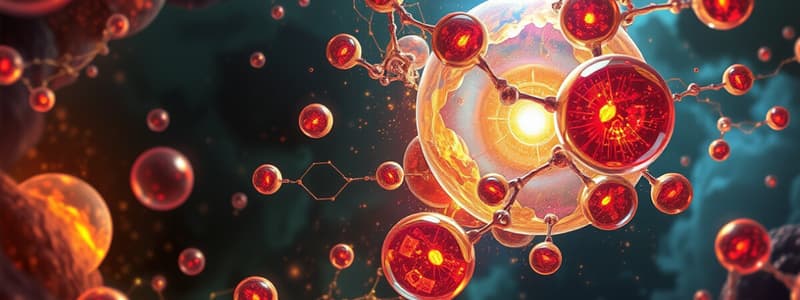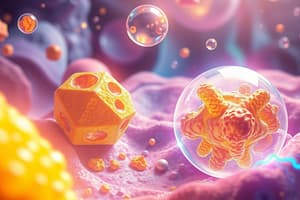Podcast
Questions and Answers
What does a negative value of ∆G° indicate about a chemical reaction?
What does a negative value of ∆G° indicate about a chemical reaction?
- The reaction does not reach equilibrium.
- The reaction will occur but is not favorable.
- The reaction can occur spontaneously. (correct)
- The reaction is endergonic and requires energy.
In the equation ΔG = ΔG° + RTlnKeq, what does ΔG represent?
In the equation ΔG = ΔG° + RTlnKeq, what does ΔG represent?
- The standard free-energy change for the reaction.
- The equilibrium constant of the reaction.
- The actual free-energy change for the reaction. (correct)
- The absolute temperature of the system.
How are Gibbs free energy changes related to the equilibrium constant Keq?
How are Gibbs free energy changes related to the equilibrium constant Keq?
- Keq determines ΔG based on reaction concentration.
- They measure the speed of the reaction to equilibrium.
- Both are independent measurements of reaction completeness.
- ΔG is calculated from Keq and absolute temperature. (correct)
What can be said about the rate of a reaction at equilibrium?
What can be said about the rate of a reaction at equilibrium?
Which statement is true regarding endergonic reactions?
Which statement is true regarding endergonic reactions?
Which of the following organisms are autotrophs that primarily derive energy from sunlight?
Which of the following organisms are autotrophs that primarily derive energy from sunlight?
Which element is not commonly seen as essential for life, aside from carbon?
Which element is not commonly seen as essential for life, aside from carbon?
What is the primary role of the functional groups in biological molecules?
What is the primary role of the functional groups in biological molecules?
Which type of isomer can have different physical properties but cannot be interconverted without breaking bonds?
Which type of isomer can have different physical properties but cannot be interconverted without breaking bonds?
What role does carbon play in biochemistry that distinguishes it from other elements?
What role does carbon play in biochemistry that distinguishes it from other elements?
Which statement about diastereomers is true?
Which statement about diastereomers is true?
What effect does the 3-D structure of a molecule have on its function?
What effect does the 3-D structure of a molecule have on its function?
What type of isomerism involves different arrangements around a double bond?
What type of isomerism involves different arrangements around a double bond?
What is the role of feedback inhibition in cellular regulation?
What is the role of feedback inhibition in cellular regulation?
Which statement best describes the conditions for a chemical reaction to be favorable?
Which statement best describes the conditions for a chemical reaction to be favorable?
Why is water considered a good solvent for life?
Why is water considered a good solvent for life?
What type of interactions are responsible for hydrogen bonding in water?
What type of interactions are responsible for hydrogen bonding in water?
What is the geometric shape of a water molecule?
What is the geometric shape of a water molecule?
How do dissolved molecules alter the properties of water?
How do dissolved molecules alter the properties of water?
What does the octet rule state in relation to the oxygen atom in a water molecule?
What does the octet rule state in relation to the oxygen atom in a water molecule?
What is the primary role of buffers in biological systems?
What is the primary role of buffers in biological systems?
What is a primary function of proteins like enolase and DNA polymerase?
What is a primary function of proteins like enolase and DNA polymerase?
Which of the following amino acids is typically not considered an alpha-amino acid?
Which of the following amino acids is typically not considered an alpha-amino acid?
What property allows amino acids to participate effectively in biochemical functions?
What property allows amino acids to participate effectively in biochemical functions?
What is an example of a protein that facilitates motion in biological systems?
What is an example of a protein that facilitates motion in biological systems?
Which of the following statements about amino acids is true regarding their side chains (R groups)?
Which of the following statements about amino acids is true regarding their side chains (R groups)?
What feature is characteristic of the alpha carbon in amino acids?
What feature is characteristic of the alpha carbon in amino acids?
Which of the following proteins is primarily involved in the transport of oxygen in the blood?
Which of the following proteins is primarily involved in the transport of oxygen in the blood?
Which of the following correctly describes weak acids in water?
Which of the following correctly describes weak acids in water?
What is the term used to describe a protein with thousands of amino acids?
What is the term used to describe a protein with thousands of amino acids?
Which of the following describes the process through which peptide bonds are formed?
Which of the following describes the process through which peptide bonds are formed?
What is the major characteristic of ionizable groups in peptides?
What is the major characteristic of ionizable groups in peptides?
How is the pI of an amino acid typically calculated?
How is the pI of an amino acid typically calculated?
What defines an oligopeptide?
What defines an oligopeptide?
Which component best describes cofactors in proteins?
Which component best describes cofactors in proteins?
How long are naturally occurring peptides typically?
How long are naturally occurring peptides typically?
What is a characteristic of dipeptides?
What is a characteristic of dipeptides?
What biological role can peptides serve?
What biological role can peptides serve?
What determines the molecular weight of an amino acid residue in a peptide bond?
What determines the molecular weight of an amino acid residue in a peptide bond?
Which of the following is NOT a type of peptide mentioned?
Which of the following is NOT a type of peptide mentioned?
What is a common function of neuropeptides?
What is a common function of neuropeptides?
What signifies the difference between N-terminus and C-terminus in peptides?
What signifies the difference between N-terminus and C-terminus in peptides?
Flashcards are hidden until you start studying
Study Notes
Energy Sources for Life
- Organisms obtain energy from sunlight: plants, green bacteria, cyanobacteria.
- Organisms obtain energy from fuels: animals and most bacteria.
Molecular Logic of Life
- Chemistry governs initiation and acceleration of biochemical reactions.
- Metabolism and signaling involve organization and specificity.
- Information and energy storage and transfer are fundamental processes.
- Life operates on a hierarchy of structure, from simple to complex.
Essential Elements for Life
- 30 elements are crucial for biological functions; common elements include hydrogen (H), oxygen (O), nitrogen (N), phosphorus (P), and sulfur (S), alongside metal ions like potassium (K), sodium (Na), calcium (Ca), magnesium (Mg), zinc (Zn), and iron (Fe).
- Carbon is central to biochemistry due to its versatile bonding capabilities.
Functional Groups in Biomolecules
- Limited number of functional groups contribute unique properties to biological molecules.
- Functional groups influence the physical and chemical properties of attached molecules.
- Complex and simple biomolecules often contain multiple functional groups.
Structural Diversity of Molecules
- Three-dimensional structure of molecules, including isomers, affects their functions.
- Types of isomers include stereoisomers, geometric isomers (cis/trans), enantiomers, and diastereomers, each having distinct physical and chemical properties.
Thermodynamics in Biological Reactions
- Free energy change (ΔG) determines the spontaneity of reactions, with negative ΔG indicating exergonic (spontaneous) reactions and positive ΔG indicating endergonic (non-spontaneous) reactions.
- Gibbs’ equation relates ΔG, standard free energy change (ΔG°), and reaction quotient (Keq).
Water: The Medium for Life
- Water constitutes 70-90% of organisms and is essential for biochemical reactions.
- It has unique properties due to its molecular structure, allowing for hydrogen bonding and influencing protein and nucleic acid structure and function.
Protein Structure and Function
- Proteins perform diverse biological functions, including catalysis, transport, structural roles, and motion.
- Made up of linear heteropolymers of α-amino acids; amino acids differ primarily in their R groups.
Peptides: Building Blocks of Proteins
- Peptides are condensation products of amino acids, classified by their size: dipeptides (2), tripeptides (3), oligopeptides (few), polypeptides (many).
- Peptide bonds are covalent links formed through condensation reactions.
Ionization and Properties of Peptides
- Peptides have distinct ionizable groups: α-amino (N-terminus) and α-carboxyl (C-terminus).
- Peptides and proteins can have diverse biological roles, ranging from hormones to antibiotics.
Conjugated Proteins and Modifications
- Conjugated proteins consist of polypeptides combined with cofactors, coenzymes, and nonprotein entities.
- Uncommon amino acids often arise from post-translational modifications (PTMs), influencing protein function.
Biological Peptides: Size and Composition
- Naturally occurring peptides vary in length from 2 to thousands of amino acids, with amino acid composition being highly variable between proteins.
- Estimating peptide size involves calculating molecular weight and residue numbers.
Key Questions about Peptides and Proteins
- Understanding the sequence and composition of peptides and proteins is essential for elucidating their functions.
Studying That Suits You
Use AI to generate personalized quizzes and flashcards to suit your learning preferences.



